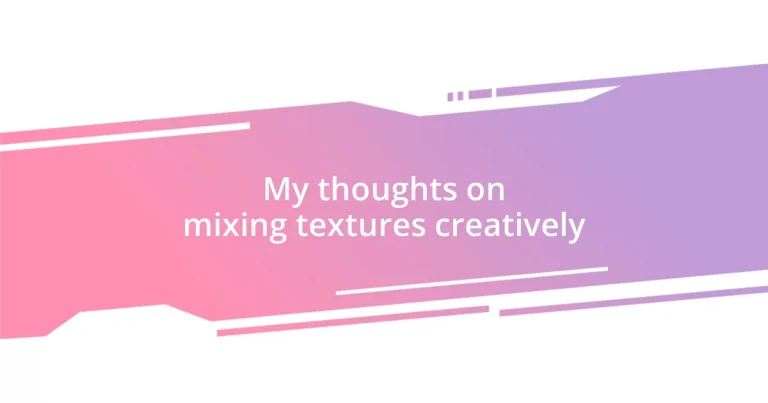Key takeaways:
- Texture significantly influences emotional responses and perceptions in design, enhancing the overall experience within a space.
- Mixing various textures creates visual interest, evokes emotions, encourages interaction, and reflects personal style.
- Effective techniques for combining textures include layering, using contrasts, and ensuring a balance that resonates emotionally with the space.
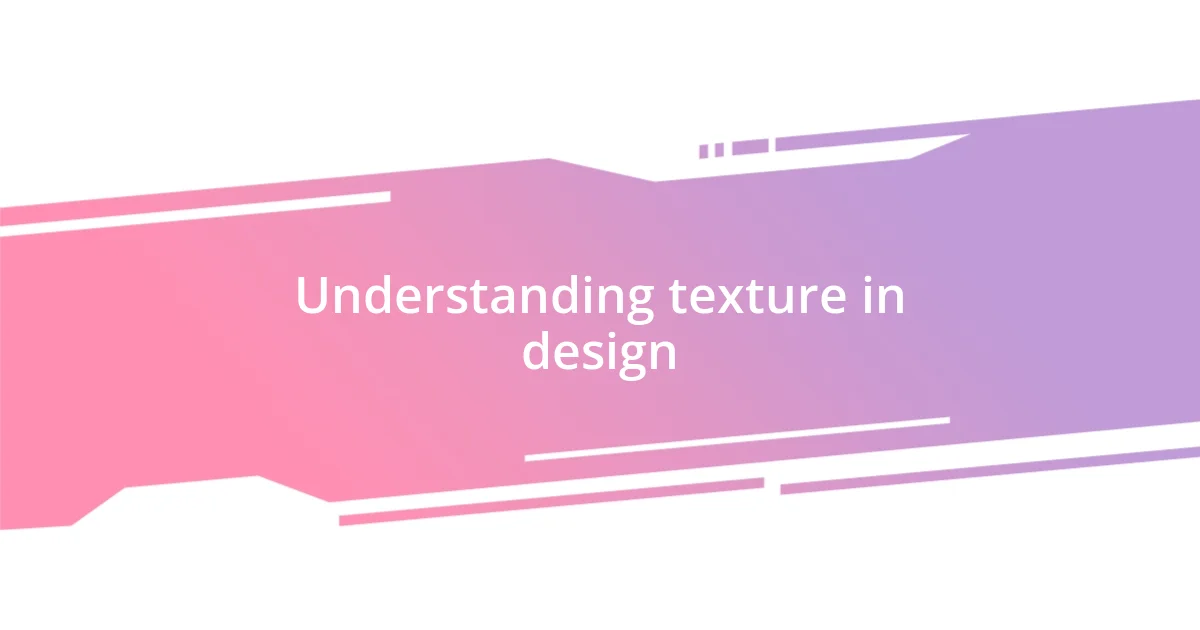
Understanding texture in design
Texture in design plays a vital role in how we experience a space or object. Personally, I remember walking into a cozy café where the combination of soft cushions, wooden tables, and a rough brick wall created an inviting atmosphere. It made me think—how does texture influence our emotions and perceptions?
Understanding texture goes beyond just visual appeal; it’s about how materials feel and interact with one another. For instance, consider the juxtaposition of a sleek metal chair against a plush, knitted throw. This contrast not only caught my attention but also added depth to the overall aesthetic. Have you ever paused to feel the difference? That tactile experience can transform a simple setup into something exceptional.
As I’ve experimented with various textures in my own projects, I’ve found that the right blend can evoke certain moods and reactions. In one of my earlier designs, I mixed glossy and matte finishes, which not only created visual interest but also encouraged people to touch and engage with the elements. Isn’t it fascinating how we might connect with a design just by the textures present?
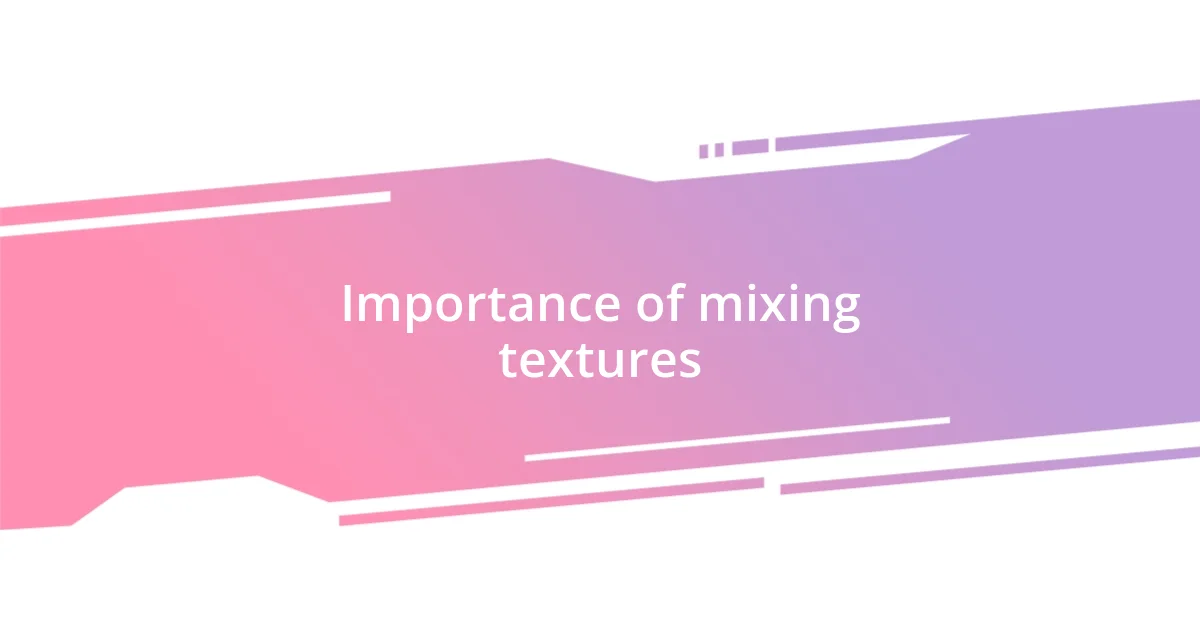
Importance of mixing textures
Mixing textures is crucial because it adds depth and dimension, making a space truly come alive. I recall a time when I decorated my living room with a combination of a sleek leather sofa and a fluffy faux fur throw. The visual contrast was striking, but the tactile experience was remarkable. People often comment on how comforting that blend feels, which highlights how texture can enhance our emotional connection to design.
Here are some reasons why mixing textures is important:
- Creates Visual Interest: A variety of textures draws the eye and keeps the viewer engaged.
- Evokes Emotions: Different textures can elicit specific feelings—softness can be calming, while roughness can feel invigorating.
- Encourages Interaction: When textures vary, people are more likely to reach out and touch, fostering a deeper engagement with the space.
- Balances Elements: Combining hard and soft surfaces can create harmony and equilibrium in design.
- Reflects Personality: Mixing textures allows you to express your unique style and preferences in a tangible way.
I’ve found that my favorite designs are those where textures speak to one another, generating a conversation that instantly sets a mood. For instance, pairing a smooth, cool stone countertop with warm, rugged wooden shelves wrapped me in a sense of comfort and stability—just like being wrapped in a familiar hug. Isn’t it amazing how those nuances can shape our experiences?
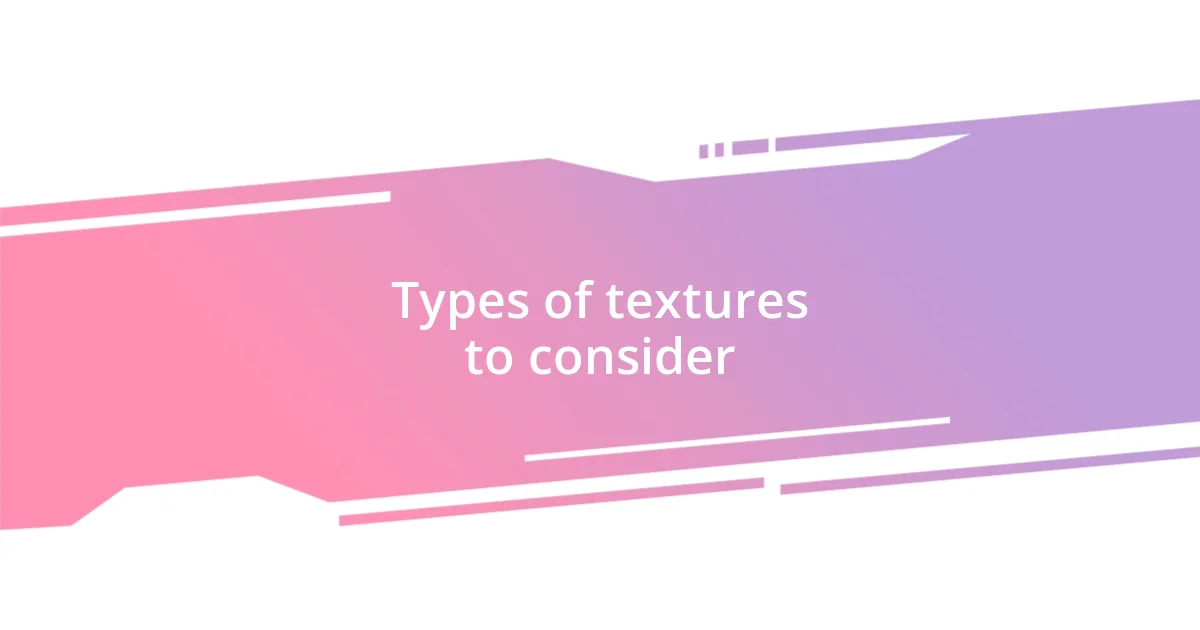
Types of textures to consider
When considering textures in design, there are numerous types to explore. Soft textures—like cotton and velvet—bring warmth and coziness to a space. On the other hand, hard textures—such as metal and stone—convey strength and sophistication. I recall a recent project where I paired a plush velvet chair with a sleek granite side table, creating a dynamic tension that truly brought the room to life.
Natural textures, including wood and stone, can foster a sense of tranquility and grounding. I remember walking through a home filled with wooden beams and natural stone flooring; the earthy feel instantly made me feel at ease. In contrast, synthetic textures like acrylic and leather offer a modern, sleek aesthetic that can cater to a contemporary vibe. Have you ever noticed how a shiny acrylic piece can reflect light and evoke excitement in a space?
Lastly, don’t overlook tactile elements like woven fabrics or embossed wallpapers. These not only invite touch but can transform a flat design into something textured and engaging. I once adorned a wall with embossed wallpaper, and the rain-like patterns created a gentle surprise that caught my breath every time I walked by. It’s little details like these that can elevate a design and make it feel lived-in and cherished.
| Type of Texture | Experience |
|---|---|
| Soft | Cozy and inviting |
| Hard | Strong and sophisticated |
| Natural | Grounding and tranquil |
| Synthetic | Modern and sleek |
| Tactile | Engaging and playful |
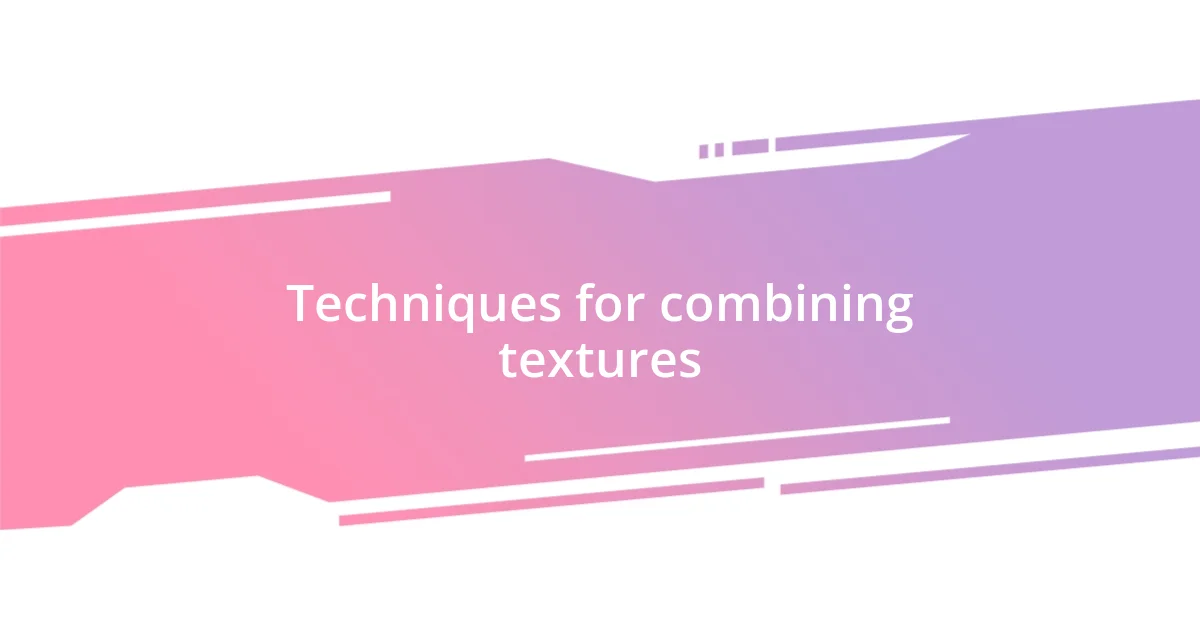
Techniques for combining textures
Combining textures creatively requires a few techniques that can significantly enhance your design. One method I love is layering textiles; picture a soft linen throw atop a woven wool blanket on your bed. This not only adds warmth but also invites curiosity. The interplay of the cool, crisp linen against the textured wool makes the bed feel incredibly inviting. Have you ever tried wrapping yourself in a pile of layered blankets? The feeling is both comforting and visually stimulating, which speaks to why texture layering works so well.
Another technique involves using contrasting textures to create visual drama. For instance, I once paired a shiny metal lamp with a coarse jute rug, and the result was eye-catching. The contemporary look of the lamp popped against the organic jute, sparking lively conversation when guests visited. Isn’t it fascinating how the right combination can serve as a conversation starter? This contrast not only catches the eye but also creates a sense of balance and intrigue in the space.
Finally, don’t shy away from introducing multiple textures within one element. I remember a stunning cake stand I saw once; it featured a smooth marble base topped with a rough-hewn wooden tray. This combination was not just about aesthetics; it expressed a beautiful harmony between elegance and rustic charm. How can you incorporate such blends into your designs? Exploring the diverse textures available can truly elevate your space, inviting both touch and admiration.
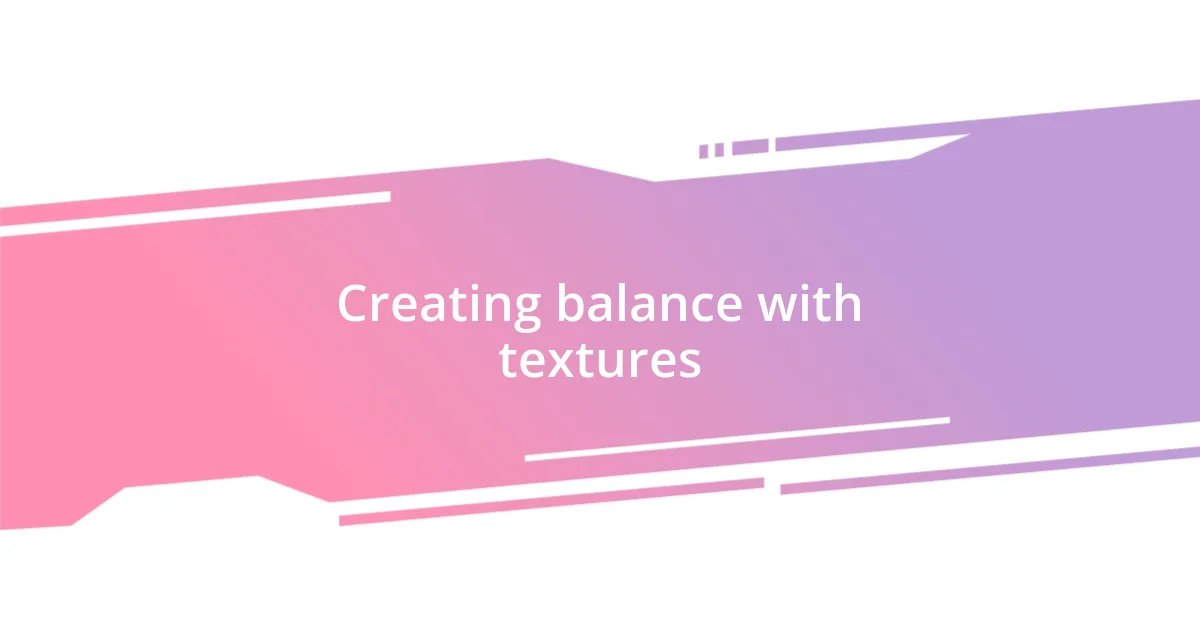
Creating balance with textures
Creating balance with textures is an art that can transform any space into a harmonious sanctuary. I often think about how contrasting textures play off each other to create depth and interest. For example, during a recent visit to a friend’s home, I noticed how she paired soft, plush cushions with a rugged wooden coffee table. The juxtaposition created a cozy atmosphere while also emphasizing each texture’s unique qualities. How can you achieve such a balance in your own environment?
One technique I find particularly effective is to establish a common thread among different textures. I once styled a living room where I used a jute rug as a foundation, adding elements like a smooth leather couch and chunky knit throws. This combination not only felt balanced but also told a story—each texture contributed to a narrative of comfort and style. Have you considered what story your textures might tell?
It’s intriguing to explore the emotional responses textures can evoke. For instance, I recall walking into a beautifully designed space filled with varied textures—each one making me feel something different, from warmth to excitement. This emotional connection is vital; it’s what makes a space feel truly inviting. What feelings do you want to inspire in your own home when mixing textures? Finding that balance between comfort and intrigue is key to creating a space that resonates with both you and your guests.
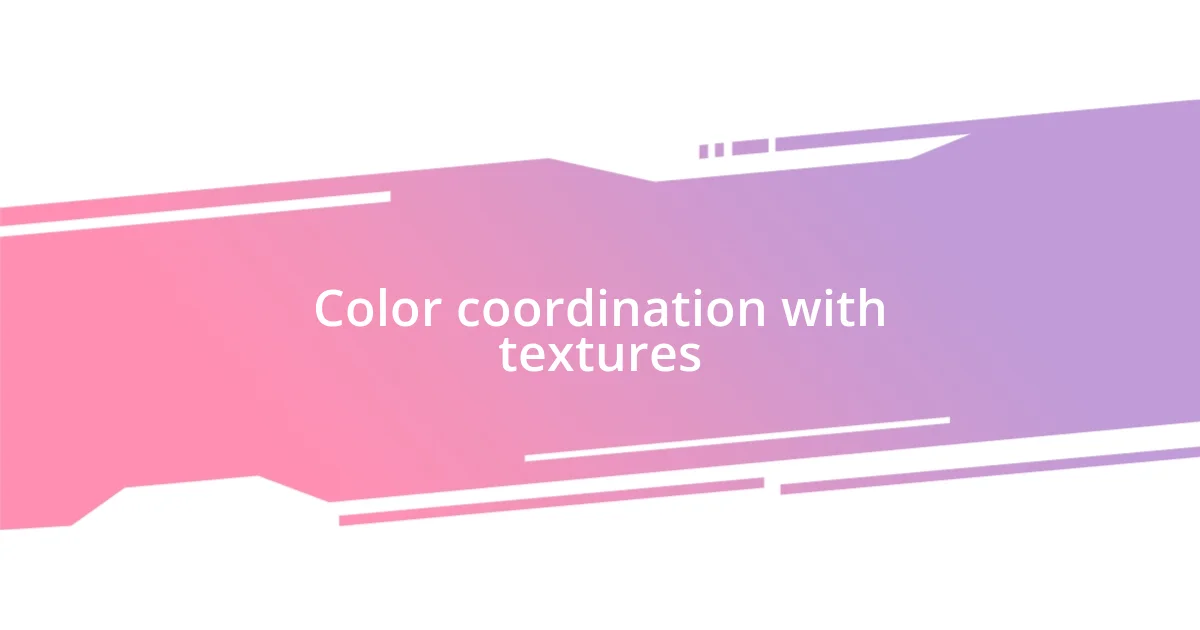
Color coordination with textures
When it comes to color coordination with textures, I’ve found that choosing a color palette can profoundly influence how textures interact in a space. I once decided to design a small reading nook with a soothing blue and earth-toned palette. Using a navy velvet cushion paired with a sandy-colored woven throw created a visual balance that felt both calming and luxurious. You can almost feel how different colors can enhance the story textures tell—what colors resonate with your mood?
I’ve also learned that contrasting colors can heighten the impact of textures in unexpected ways. For example, I experimented with a vibrant, mustard yellow chair sitting against a rich, dark leather sofa. The juxtaposition made both pieces pop, inviting a closer inspection of their distinct textures. Why do you think some combinations create such a buzz? It’s all about sparking intrigue and encouraging interaction in a space.
One emotional insight I cherish is that cohesive color and texture combinations can evoke a sense of comfort that wraps around you like a warm hug. I remember attending a gathering at a friend’s home where she used muted greens with various natural textures—soft cottons, smooth ceramics, and rough baskets. The mellow colors, paired with the textures, enveloped everyone in a welcoming embrace. How does your ideal space make you feel? Exploring the interplay between color and texture can lead you to discover not just aesthetic beauty but also emotional resonance in your environment.
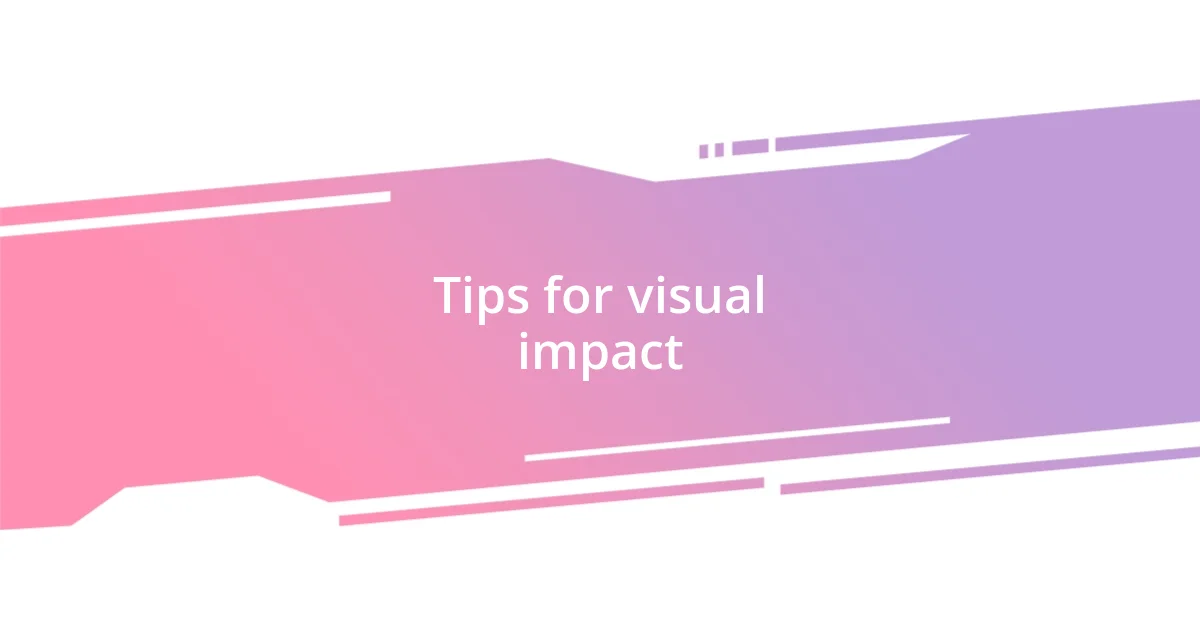
Tips for visual impact
To create visual impact, I like to think about layering textures in a thoughtful way. For instance, during a home makeover, I placed silky drapes over a rustic window frame. The play between the smooth fabric and the rough wood added a dynamic touch that transformed the entire room. Have you ever noticed how one simple layer can change the feel of a space?
Another approach is to use varying sizes and shapes within your textures. I remember styling a friend’s bookshelf where we combined tall, angular ceramic vases with short, round wooden bowls. This intentional contrast not only created visual interest but also encouraged the eye to dance across the arrangement. How often do you consider the shapes of your decorative items when mixing textures?
Don’t underestimate the power of tactile experiences. I once visited a café that featured a wall adorned with an eclectic mix of fabrics—velvet, burlap, and satin. Touching those surfaces as I waited for my coffee made me feel more connected to the space. The sensory elements of texture can evoke memories and feelings, drawing people in. What textures do you think your guests would love to experience in your home?












